Knowing The Kneebar With Dean “The Boogeyman” Lister.

The mysterious kneebar; what it is, how does it happen, how do you do it, how do I defend it, will my knee pop off if I get caught in one? These are all questions that have surely entered anyone’s mind as a white belt. One man who’s managed to use the leglock as his friend over the years sheds some light on the subject. That man is Dean Lister. In the world of jiu-jitsu few have reached the pinnacles of success that Dean has. Dean won the Absolute division at the 2003 ADCC, beating legends in the sport as a 26 year old brown belt. Today, Dean has amassed a respectable career in jiu-jitsu as well as professional MMA having fought in Pride, King of the Cage Championship, and has a winning reccord in the UFC. We had time to sit down and learn some amazing kneebar finishes with Dean and get to know him a little better.
How did you get into jiu-jitsu?
I was already into high school wrestling and I heard about Gracie Jiu-Jitsu. It seemed like something I wanted to try. I was already doing sambo. Sambo guys usually have good submissions from throughs, but generally don’t have a good “ground game.” I was already doing submissions and jiu-jitsu made more sense to me than having to pin someone from on top. I took my first class with Fabio Santos here in San Diego and I loved it. Been training ever since.
Did you grow up here in San Diego?
I was born here, but raised all over the world. My father was a US Marine. I grew up in Venezuela, Panama. That’s probably why I became a fighter. If you’re the only kid that looks one way, and everyone else looks different, you’re going to get picked on. Unfortunately, it just seems like human nature. I don’t blame the Panamanian kids for hating me, a lot of their people lost their lives when we went in there back in ’89. I don’t blame them for hating us. I’d say a few times a week I’d get into a fist fight. Sometimes with one kid, sometimes two. That desire to defend myself is what ended up leading me to jiu-jitsu, now that’s my life.
Back then you were about twelve years old, were you big for your age?
No, back then I was small. It wasn’t until I got to about 17 years old that I got bigger, I grew real fast.
Were your parents big?
On my dad’s side the men weren’t too big, but on my mom’s side the men are all pretty tall and big.
What’s your ethnic background?
I’m all kinds of things. I kid around and say I’m a white guy that can tan well. I’m not latino at all, but I can pass for it. I speak Spanish, Portuguese. I’m one quarter Apache, Native American, French, Scottish, Dutch, and probably a few more things. I need to go to Ancestory.com to check it out.
When did you earn your black belt?
I got it in 2003, after I won the brown belt at Abu Dhabi. It was a little controversial. I split up with my first instuctor. We had a split up, and I started my own school. At the ADCC I lost in my weight division to Xande Ribeiro on points, by a lot of points. Usually I’d only lose by just a couple. Then somehow I got into the Absolute division, I was like the fourth alternate. In the first round Xande lost to “Cacareco” (Alexandre Ferreira) with a footlock. At the time Cacareco was like the best Brazilian with footlocks. So then I beat Nate Marquardt, Saulo Ribeiro, Marcio Pe De Pano and ended up facing Cacareco in the final and won with a footlock. That was when I saw my own way of using jiu-jitsu. When I got back, my friend Jeff awarded me a black belt. Said it was crazy that I didn’t have it considering who I beat at the ADCC. That sparked some controversy with him and Fabio Santos. Politically it wasn’t correct. It’s all been made up now and we’re all cool now.
How did you get to become so comfortable and known for your footlocks?
When I was younger, maybe as a blue belt, I was told that footlocks were not so technical. The choke is the King, the armlock is the Queen, and the footlock is the dirty theif in the night. It’s not comparable, even though it’s a submission. I never listened to that. I think they’re all submissions. If I footlock someone it’s probably because they’re high level, they’re good at guard, they’re hard to pass. As I’m passing, their legs are in the way so I’ll go for a footlock. If they’re a wrestler they might go to their knees, in which case I’ll jump on the back and go for a choke. Depends on who I’m facing. I can do all those other locks, but it’s usually against advanced guys that I get the leglocks on because that’s where the opportunity is. When someone defends my leg locks I can usually pass their guard. So the two skills really complement each other. They defend the pass, I go for the legs, they defend the legs, I go for the pass. They pair up perfectly.
Do you bait with the leglocks or the pass?
All the time. I beat Rodolfo Viera, the great Brazilian fighter. I was across the side of him and I gave him a little bit of space because I knew he was going to replace the guard. He did, and that was enough for me to get his leg. If he didn’t try to put me in guard I wouldn’t have gotten the leg lock. He’s a high-level competitor, he’s going to play his game. By the way, I bring up these guy’s names with nothing but respect. I have huge respect for all my competitors. These are all high-level guys. I really respect them a lot.
What’s your conditioning like?
Conditioning is never easy, but it’s very simple. If I’m training for MMA I’m going to do more boxing, kickboxing, wrestling, and jiu-jitsu. With jiu-jitsu and Metamoris 3 I’m going to be rolling a lot, hard! I may go on some runs. I trained Rulon Gardner at some point and asked him how he got so strong and he said, “I just wrestle. While other guys would go run I’d wrestle more.” I’ll run if I have to lose weight. I hated hearing this type of answer when I was young, but all the greats at jiu-jitsu would tell me to roll more. I’m not doing chin-ups in a match, I’m pulling on an opponent; so the more I can do that the better I’ll be prepared. Everything can help a little I suppose, but I have 100% crossover from training into my matches.
In all my training I start from bad situations from the bottom to get on top. I earn my way out of submissions to get submissions. It’s because of this I’m pretty resilient, it’s hard to finish me, and I have good defense. It’s cliché, but people say the best defense is a great offense, but if you’re always on offense then your perfect. No one is perfect and it’s impossible to always be on offense. I practice my defense to set up my offense. I start in a triangle or an armbar and it makes my muscles stronger, as well have double of a workout than that of my training partner.
So you’ll actually start in a full on submission?
Yes, I will. My arms may be locked while defending the armbar or it will be full extended and my partner will go 30%. These are only done with trusted training partners. We’ll start in Kimuras, Americana, heel hooks, and other twisting submissions where the partner will only hold the position. At my school no one ever gets hurt from heel hooks; it’s always from wrestling or falling. We’ll start in armbars, triangles, and footlocks with pressure and escape as well. If you tap, it’s no big deal because you’re training yourself how to learn not to tap.
How’s your diet?
I used to be more diciplined when I was younger. The personality of a fighter usually isn’t a guy that sits around and eats carrots all day. I guess if you have that type of personality it’s great. But that’s not me. My diet’s on point when I want or need it to be.
Any advice you’d give to other practitioners?
“Your mind is like a parachute; it only works when it is open.” Have an open mind. Even if someone doesn’t practice jiu-jitsu you can learn something; from a wrestler, from a sambo player, a lower belt, someone overly calm, some people with a temper. You can learn from anyone. Know what you’re good at. If you’re a blue belt and good at triangles you can build upon that. Could be a different move, but it’s your go to move, and you can build your style temporarily around that strategy. This will build your confidence and once you have that you can start learning a lot better.
Do you have any upcoming events or projects?
I have two new websites www.deanlisterleglocks.com and coming soon will be www.subhumanz.com with Jeff Glover. Also my DVD “K.A.T.C.H. Leg Lock Systems” just came out and of course my match against Babalu at Metamoris 3 on 3/29/14. Also, I have a Fight House Program. It’s about $35 a day. The fighters get to come train, a room to stay in at the beach, full kitchen, place to hang your gi, alkaline drinking water, even cable TV. It’s shared living, four beds in one room, but it’s on the beach and you get to stay with me. Shoot me an email if you’re interested, deanlister@gmail.com.
Dean’s Fundamentals of the Kneebar
Dean prefers to call it a knee lock, but for the purposes of this article we’re going to call it a kneebar, sorry Dean. Below is Dean’s primary finishing position for the kneebars discussed in this article.

Locking the Figure-Four
Tuck the foot between your neck and shoulder, with the Achilles firmly in the crook of the elbow. Go the extra mile and grab the foot by the toes with your other hand and lock it down by placing your free hand on the crook of your other arm to create a figure-four, as if you’re performing a rear naked choke on the ankle.

The reason Dean likes to use his arm closest to the mat to attack the leg is because this side is less likely to be pushed away. When Dean uses his other arm to attack the leg his opponent can use their free leg to kick the arm off at the elbow. When the lower arm is trapping that counter is taken away.

Many people tend to perform the kneebar with the leg caught behind the high-side arm. Dean says this is great if you happen to get it. However, in the transition from taking the leg from in front of you to behind your arm, there’s the instance when you have to loop your arm around the leg. At this moment your opponent has an opportunity to turn out of the hold. This is why Dean prefers attacking the leg as he does.

Straight Kneebar from Half-Guard
Dean really likes this submission from the half-guard. Dean got the legendary Saulo Ribeiro with this technique at the ADCC.
1. Dean’s in Jeff’s half-guard. In order for this technique to work best, Dean wants Jeff to be on his side. If Jeff is flat on his back this one is actually more difficult, and maybe Dean will look to mount, or pass. One way to get your opponent into position is to fake with a Kimura, they’ll respond by pushing forward. When they do this release your grip on their arm.
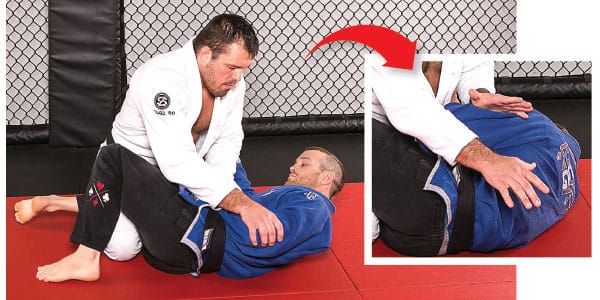
2. As your opponent pushes back release your grip of their arm and raise up slightly, enough to swing your left leg over and across their body.

3. Turn your left foot in toward them and swim it underneath the leg you’re attacking. If you just bend your knee and allow your foot to be exposed they can counter with a toehold.
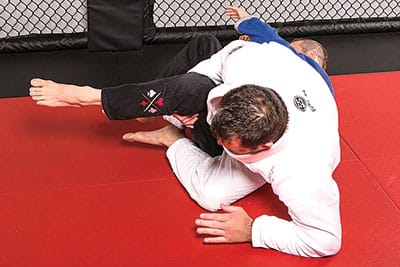
4. Fall to your left side once your left foot is tucked underneath their leg, begin to secure their leg as you fall.
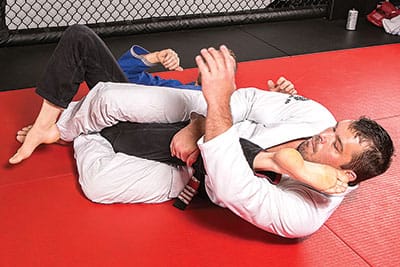
5. Hug the back of their ankle with your left arm as shown earlier. Then grab the toes with your right hand and lock up the figure-four. Hip out to finish. Be sure to Extend your feet past their hip and cross them.
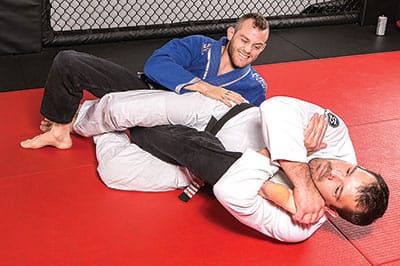
Key Points
Drill this technique by pivoting on your right knee to spin your left leg around. Practice both sides, and be sure not to kick your partner in the face as you come around.
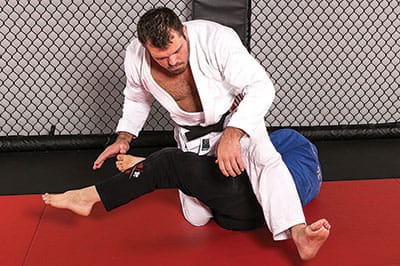
The reason this technique doesn’t work well when they’re on their back is because there is no space for you to put your left foot as it comes over. That’s why Dean will go with something else until they get into the position he wants.
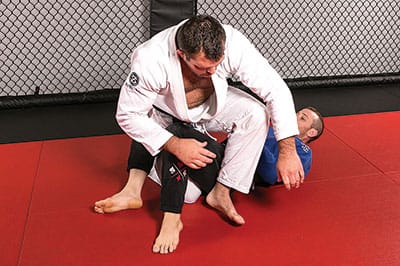
Half-Guard Pass for Flat On Their Back
Dean loves the leg locks, but lets say his opponent’s got him in half-guard and is really inclined to stay flat on their back. Here’s a simple pass that you can try.
1. Jeff won’t fall for it and he’s staying flat. Dean grabs Jeff’s right sleeve at the cuff then Dean brings his left leg up and over and plants it to the side of Jeff’s left hip.
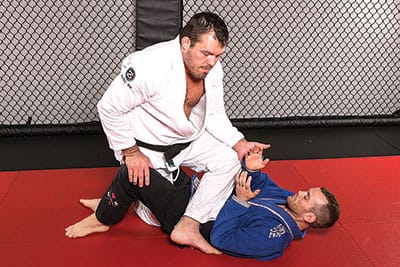
2. If Dean were to stop here that would be bad, but instead Dean pushes off on his left leg to stand while pushing down on Jeff’s knee with his right hand.
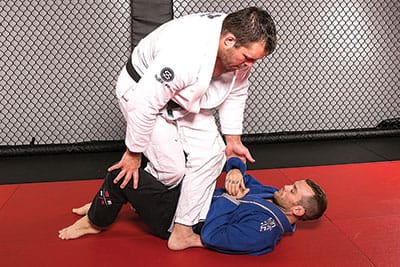
3. It will be very difficult for Jeff to keep a hold of Dean’s right leg and he can just pull it out.
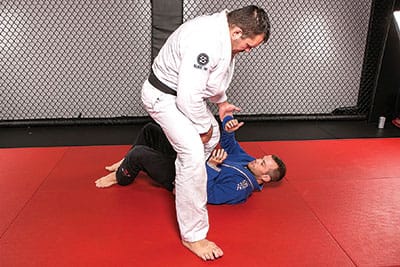
4. From here Dean can drop down into knee on belly or go for some other attack.
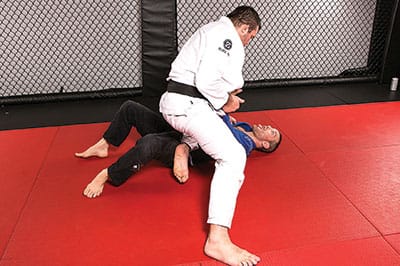
Key Points
This pass works great with no-gi, you just have to grab the wrist and go a little bit faster than you would in the gi.
Cartwheel Kneebar
In the gi, Dean prefers this next technique over the previous one. It’s extremely effective. This technique works so well because it’s so unconventional.
1. The first thing Dean does is get a pistol grip of the sleeve cuff on Jeff’s left arm. It’s important to get a pistol grip, a standard four fingers over the cuff won’t allow you to plant your hand correctly.
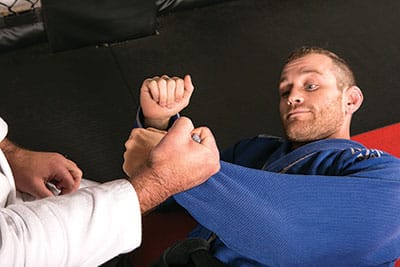
2. Once the grip is secure, drive your opponent’s arm to the mat in front of them. Put your weight down with this grip so that they can’t move their arm.
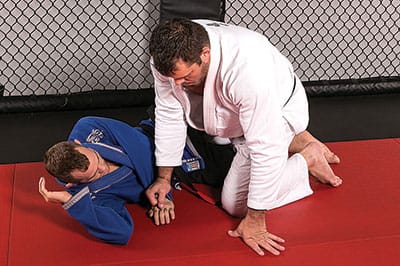
3. Once the hand is planted, swing your left leg over around to your left, as if you’re doing a cartwheel. At this point you’re turning your back to your opponent, but as long as you have that grip at this time you’re safe.
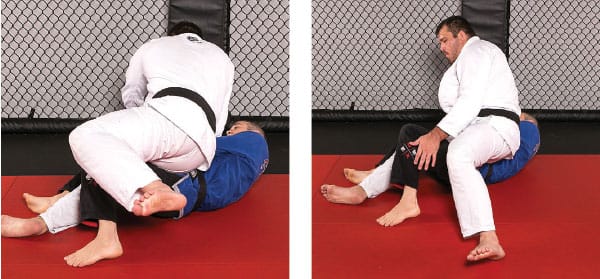
4. If your opponent straightens his right leg simply pull your right leg back for the pass to side control.
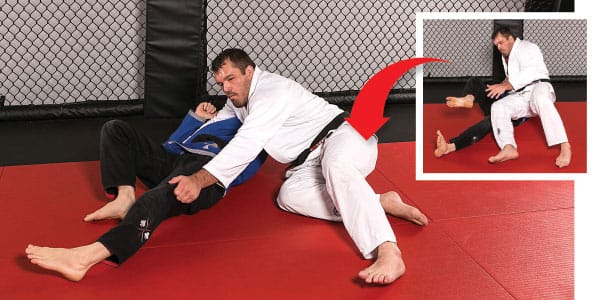
5. Let’s say he doesn’t straighten his leg. In that case, wrap your free left arm around his left leg.
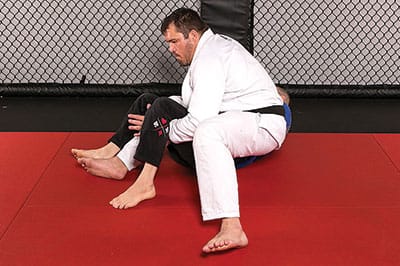
6. Hug it tight to your body, let go of the grip of the sleeve and fall to your left side.
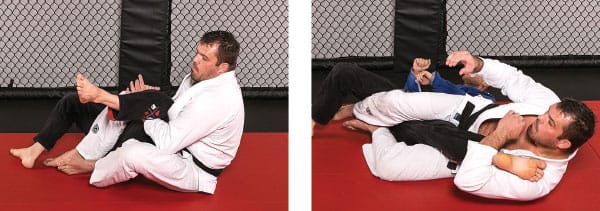
7. Put his leg in position as shown previously, control the toes, lock down the figure-four and hip out to finish.
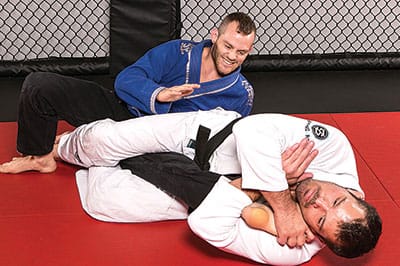
Key Points
The grip of the sleeve or arm is EXTREMELY important. If you lose the grip your basically giving your back to your opponent. That’s what makes this a little more dangerous without the gi.
This technique sets itself up when your opponent grabs your collar, that’s the perfect opportunity to break his grip and hold onto the sleeve.
If after you’ve brought your left leg over he keeps his knee bent with a hook under your right leg, push his knee down to the mat to pass.
Kneebar from Half-Guard Bottom
This is one of those techniques that your opponent has probably never seen. You’re banking on that to a certain degree. In the middle of the move there’s an opportunity for your opponent to sprawl out. Drilling this technique consistently will help a lot with your timing to avoid this sprawl.
1. For this one, Dean has Jeff in his half guard. Dean gets a hold of Jeff’s far sleeve, in this case Jeff’s left sleeve. Instead of the pistol grip, Dean goes with the standard four-fingers on the outside of the cuff.
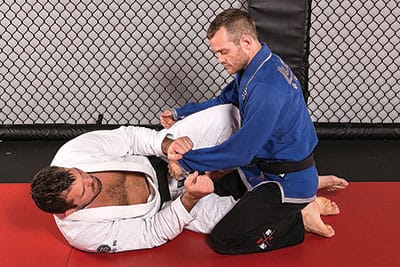
2. If you aren’t already, get on your right side so that your far hip is off the mat. Bring your left leg up and across your opponent. At the same time, quickly hook your right hand inside and under his left thigh, if you can grab the pants.
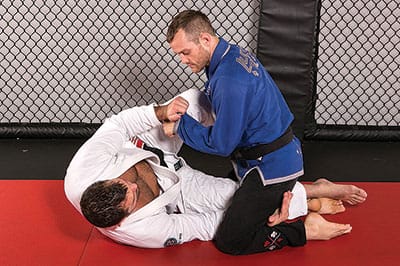
3. Once you get that inside hook on his thigh and your left leg has cleared his body, point that left leg straight out and bridge up on your right shoulder.
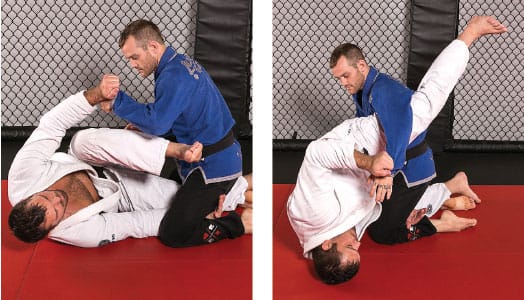
4. Maintain your grip of his sleeve and thigh and use your energy to pivot to your left side, dragging your outstretched left leg up to his armpit and toppling him over to the mat.
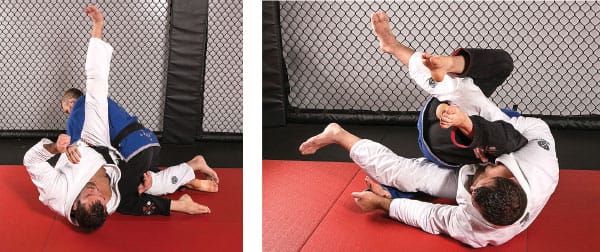
5. As he’s rolling, ditch the grip of his sleeve and continue the roll so that you’re ending up on your left side with his left leg right there for the kneebar.
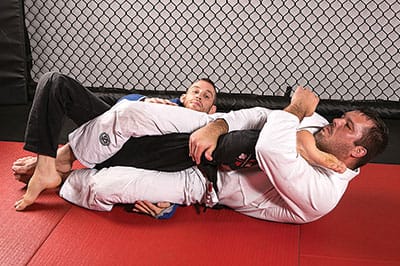
6. Do all the things you need to do, legs out past his hip, capture the foot with your hands, lock down the figure-four and finish the kneebar.
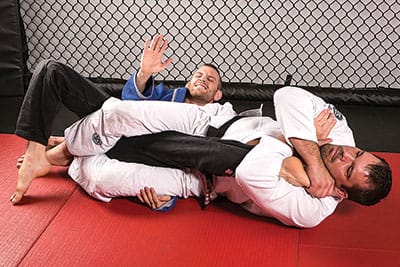
Key Points
Once you bridge up in step 3 he’s probably going to pressure into you, this helps your cause and allows you to roll him over more easily.
At step 2 when you bring your leg across his body there’s a chance for him to sprawl out and pass your guard. Drill it over and over until you get your timing down to avoid this from happening. Also, bridge and extend your hips as quickly as you can, this will make it harder for him to sprawl.
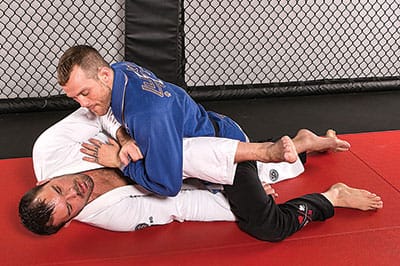
Sweeping Kneebar from Half-Guard Bottom
This one starts off with your opponent in your half-guard and you sweeping them over. In the worst case if you don’t get the finish you’ve swept them, and in the very worst case you can move into deep half-guard if you’re so inclined.
1. Once again Dean’s got Jeff in his half guard, Dean scoops his right arm under Jeff’s left leg as if to go for a sweep.
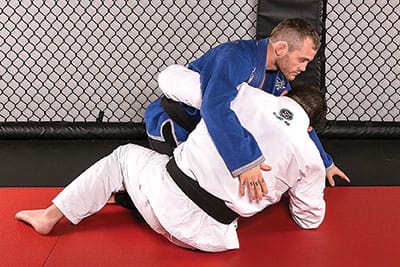
2. Dean reaches over Jeff’s back with his left arm, gabbing the belt.
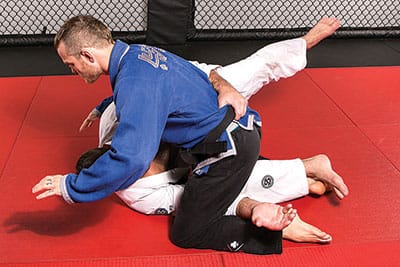
3. Now Dean goes for the sweep and rolls to his left side, using his underhook of Jeff’s thigh and belt, along with momentum from his left leg to roll Jeff to his left side.
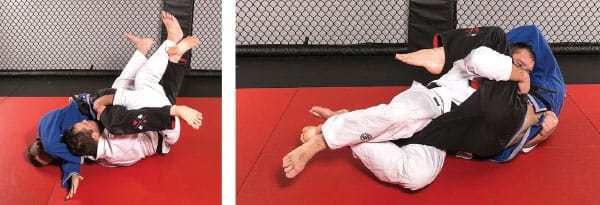
4. As the two roll, Dean will cross his legs behind Jeff’s calf.
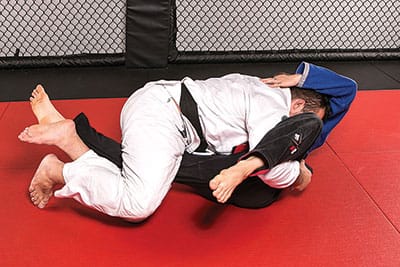
5. As the momentum continues, Dean settles with his knees on the mat and Jeff’s left leg stretched out between Dean’s leg. Jeff’s still in Dean’s half-guard, only this time Dean’s on top.
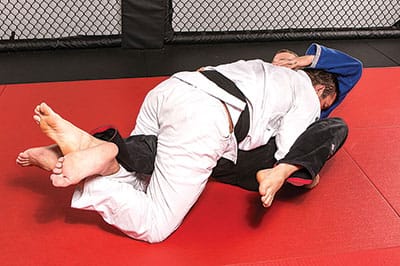
6. Dean uses his arms to control Jeff’s hips. Now Dean puts his hip into it, feeling his crotch above Jeff’s knee to finish. Dean can also curl his legs more to finish as long as they’re crossed behind Jeff’s leg.
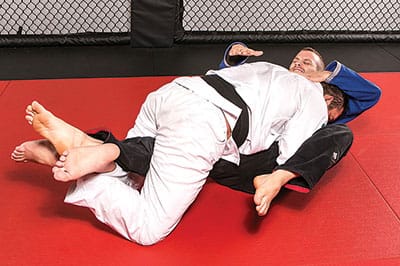
Key Points
This technique works on more advanced opponents because they face you and that’s needed to pull off the submission. Lower level opponents might turn away to avoid the submission, in which case you take their back.
Dean will bait with a guillotine and let the other guy thing they’ve got something while he sets up his grips and goes for the sweep.
It’s important that Dean’s legs cross underneath Jeff’s leg. If they’re off to the side he won’t get the submission.
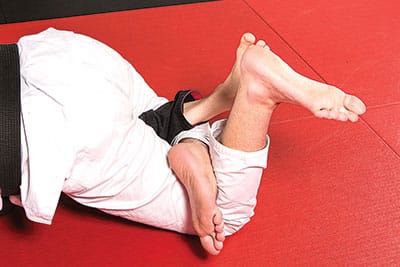

Passing Kneebar from Half-Guard Top
In the previous technique Dean uses a sweep to get Jeff in position to finish. The same mechanics can be employed from the top of the half-guard to get the same submission.
1. Dean starts in Jeff’s half-guard. Dean must scoop his right hand underneath Jeff’s left leg and get that leg up high on his shoulder.
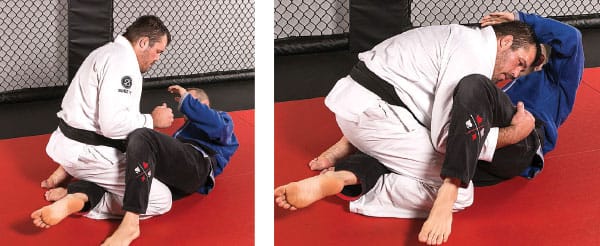
2. With his left hand Dean scoops it under and behind Jeff’s right thigh. This is a little difficult to do since Jeff’s weight is blocking, so be deliberate with this move.
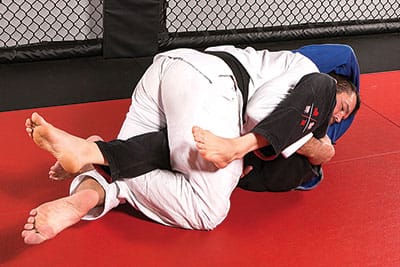
3. Now Dean crosses his legs under Jeff’s outstretched right leg.
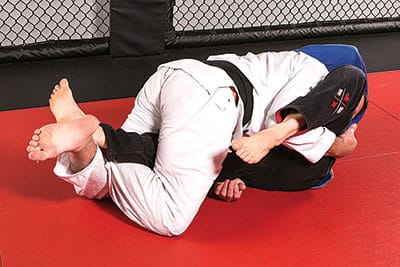
4. Once the legs are crossed properly, Dean can either hip in to finish or curl his legs.
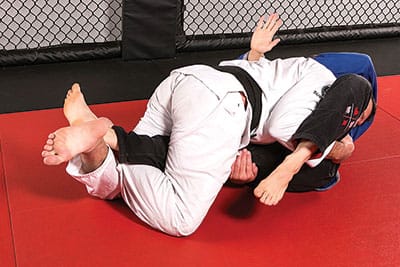
Key Points
If Jeff were to turn away from Dean he’ll end up giving up the back.
This technique puts a tremendous amount of pressure on the knee and can come up quickly. Practice with care for your partner.
Defending the Kneebar
In gi training most people don’t begin to see kneebars until Purple belt, and then much more often in Brown. As a veteran purple I’m starting to play a lot more with kneebars and one thing I want to know is how to properly defend them. We asked Dean for a few pointers on defending the kneebar.
Before your opponent can pull back on the knee, while it’s still bent, triangle that leg with your other leg. In this set of photos Dean can move up to his knees after he’s closed the triangle.

If the knee’s already extended you might be done depending on the opponent. Dean will bring his other leg up to push on the back of his opponent’s knee. Then plant his hands to the mat and pull himself away, brining his leg and knee along with him.

